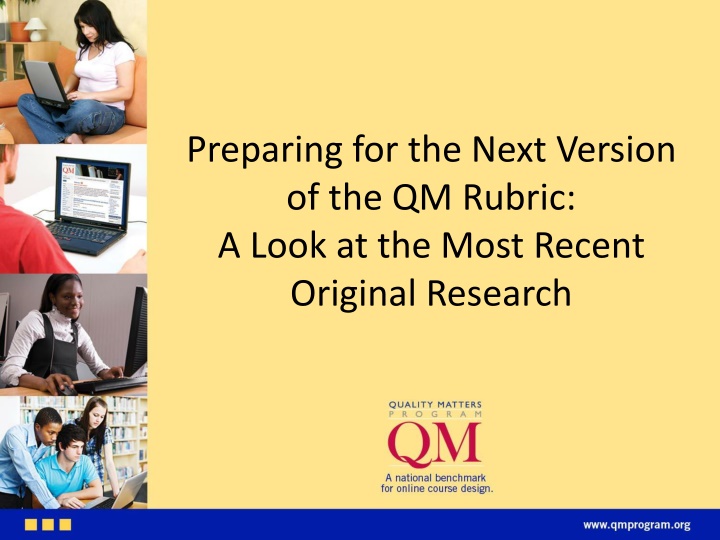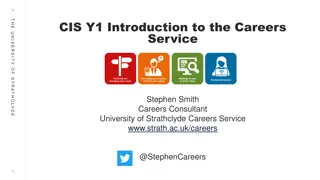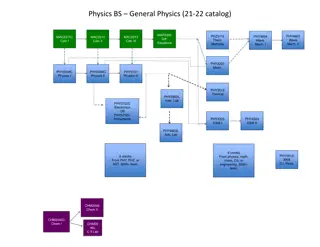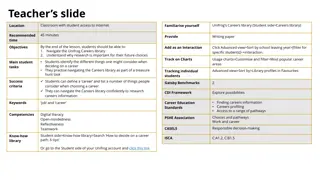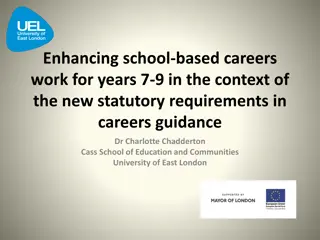Women's Careers in Physics: Results from Global Survey of Physicists
This study delves into the challenges faced by women in physics, highlighting issues of underrepresentation, biases, and lack of recognition. Through a global survey, insights are provided on opportunities, resources, work-life balance, and common problems encountered by female physicists worldwide.
Download Presentation

Please find below an Image/Link to download the presentation.
The content on the website is provided AS IS for your information and personal use only. It may not be sold, licensed, or shared on other websites without obtaining consent from the author.If you encounter any issues during the download, it is possible that the publisher has removed the file from their server.
You are allowed to download the files provided on this website for personal or commercial use, subject to the condition that they are used lawfully. All files are the property of their respective owners.
The content on the website is provided AS IS for your information and personal use only. It may not be sold, licensed, or shared on other websites without obtaining consent from the author.
E N D
Presentation Transcript
Preparing for the Next Version of the QM Rubric: A Look at the Most Recent Original Research
QM Research Colleagues Bethany Simunich, Ph.D. , Kent State University Joan Milkalson, Ph.D., Excelsior College Julie Frese, Ph.D., University of the Rockies Li Wang, Ph.D., Ashford University Sharon Lalla, Ed.D., New Mexico State University Kay Shattuck, D.Ed., Quality Matters
Agenda for session Outline how research informs the revision of Rubric Describe the QM research review process Present samples of interesting current studies Identify themes from current lit review
Review of research Analyses of peer review data Feedback from QM community Rubric Review Committee 2014 Edition of the HE QM Rubric
Analyses of Peer Review Data Statistical analyses of data collected from QM managed & subscriber managed reviews N=1,494 2010 analysis informed work of 2010 Rubric Review Committee Recently completed analysis will inform work of 2014 Committee Inter-Rater agreement by standard Lowest levels of inter-rater agreement will be examined Might be indicative of unclear items or need for further training of raters Analyses by Whitney Zimmerman, Doctoral Candidate , Ed Psychology, Penn State
Research Review: Academic Databases Searched Academic Search Complete ERIC Course/Instructional Design Keywords Google Scholar ProQuest
Sampling of 21 Peer-reviewed journals followed The American Journal of Distance Education Distance Education Open Learning: The Journal of Open, Distance and e-Learning The Internet and Higher Education Journal of Computing in Higher Education Journal of Asynchronous Learning Networks The International Review of Research in Open and Distance Learning Educational Technology Research and Development
Review of research literature that will inform the work of the 2014 Higher Education Rubric Review Committee
Sampling of some interesting studies reviewed (so far)
Interesting study Swan, K., Matthews, D., Bogle, L. , Boles, E., & Day, S. (2012). Linking online course design and implementation to learning outcomes: A design experiment. Internet and Higher Education, 15(2), 81-88. Why this article? Preliminary results show that using QM to redesign a course that is mapped to learning objectives can improve student achievement in those outcomes.
Possible implications Study directly looks at connection of QM/learning objective centered design on student learning; supports efficacy of QM and design-based approaches to learning.
Interesting study Pollard, H., Blevins, R. Connor, M., & McGovern L. (March, 2013). An examination of the relationship between teaching presence, social presence, learner motivation, and self-reported learning among online MBA students. The Journal of American Academy of Business, Cambridge. 18(2) 23-30. Results showed teaching presence, social presence, and learner motivation were significant predictors of self- reported learning. These collective factors could explain 91.7% of the variance in self-reported learning.
Implications How can we design courses that promote the Community of Inquiry Framework that includes teaching, social, and cognitive presence?
Interesting study Ulrich, J., & Karvonen, M. (2011). Faculty instructional attitudes, interest, and intention: Predictors of Web 2.0 use in online courses. Internet and Higher Education, 14(4), 207-216. Why this article? We already know that pedagogy should drive the technology, but faculty knowledge and interest also play a key role in choosing course tools and media.
Implications Faculty course designers need to have some base knowledge about current tools & media, as well as their pedagogical uses, so that they are seen as viable options when selecting technology that supports course learning objectives.
Interesting study Tunks, K.W. & Hibberts, M. F. (2013). A Comparison of Instructor Evaluations for Online Courses. Online Journal of Distance Learning Administration. 16(2). Retrieved from http://www.westga.edu/~distance/ojdla/summer162/tunks16 2.html TIE OIE
Implications Key student retention milepost. Richard Lyon 8.a.Instructor provides students opportunity to ask questions as the closure and insight into their accomplishment . 8.b Instructor provides students with feedback about their overall learning and progress, and experience of the semester. 8.c Instructor provides students opportunity to reflect their learning and connect their learning goals with the expectation of the instructor.
Interesting Study York, C.S. & Richardson, J.C. (2012). Interpersonal interaction in online learning: Experienced online instructors perceptions of influencing factors. Journal of Asynchronous Learning Networks, (16)4, 83 98. Retrieved from http://sloanconsortium.org/publicatons/jaln_main Three Types of Interactions (Moore, 1989): learner-learner, learner-instructor, learner-content Interactions are a critical factor impacting learning Interpersonal interaction affected by: course structure, feedback, facilitating discourse
Implications Social presence is important to the learning environment Importance of creating a sense of community online Factors that increase interaction in online courses: group work, course environment, model use, community, discussion question type and assessment, feedback type and medium, immediacy behaviors, discourse guidelines, and instructor participation
What about MOOCs? (The QM Continuing and Professional Education Rubric is used to review MOOCs)
MOOCs Lots of reporting (some off the cuff, some statistical) Mostly focused on descriptive (#s, completion rates) We re following for research re instructional design Please take advantage of many presentations re MOOCs at the conference
Themes were seeing in the current research Alignment, scaffolding, and clarity continue to be emphasized Tools and media are dynamic and changing, but are still the primary means to promote collaboration, presence, and engagement Growing emphasis on interaction as a driving force in learning. The topic of presence is seen in much research.
Community of Inquiry Framework: The Dominant Research Theme http://communitiesofinquiry.com/model
Discussion of CoI and QM CoI is currently dominant research framework for studying online learning Swan & colleagues suggest there is an orthogonal relationship between QM and CoI QM focuses on design, while CoI focuses on process Both impact outcomes, but view learning from different perspectives and so measure different things Swan, K., Matthews, D., Bogle, L., Boles, E., & Day, S. (2010). Linking online course design and implementation to learning outcomes: A design experiment. [2010 QM Research Grant University of Illinois Springfield]
